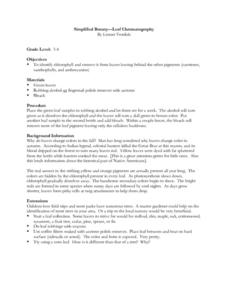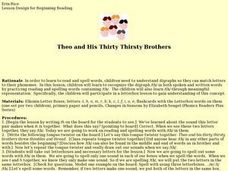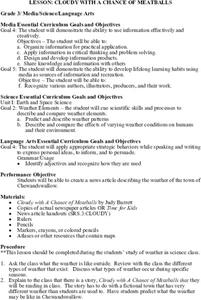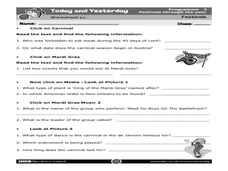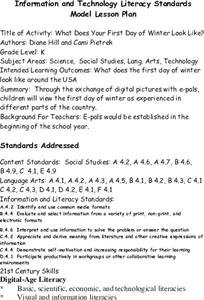Prestwick House
Teaching Shakespeare: Sonnet 73
It's that time of year to consider how Shakespeare selects his images and structures his Sonnet 73 to develop the meaning of the poem. Class members examine the rhyme scheme, the indented lines, the conceit, and the images used in each...
News Word
Hanukkah
How much does your class know about the Jewish Festival of Lights? Young learners practice Hanukkah vocabulary, including latkes, Judea, sufganiot, and gimel, in a series of word puzzles.
Curated OER
Simplified Botany--Leaf Chromatography
Students investigate the different pigments contained in green leaves by completing an experiment that strips away the chlorophyll and separates the pigments left behind.
Curated OER
Fall Trees
Pupils create fall trees using brown paper, tissue paper, background colors, glue, markers and crayons in this Art and Science instructional activity about the changing of seasons. Emphasis is placed upon learning about the Fall season...
Curated OER
Products of an Electrical Engineer
Students explore products made by an electrical engineer. For this engineering lesson, students complete two worksheets identifying products made by an electrical engineer.
Curated OER
Creative Position Word Center Activity
Students use positional words to describe the location of objects and demonstrate the ability to follow multi-step oral directions. Seasonal shapes are decorated in relation to the directions and positions stated by the positional word.
Curated OER
Spring Vocabulary
In this spring vocabulary activity, learners analyze 20 words pertaining to the season of spring and match them to the correct meanings in another column.
Curated OER
Savannah Word Search
In this science word search, students find the words that are associated with the biome of the savannah and the answers are found on page two.
Curated OER
Theo and His Thirty Thirsty Brothers
Students recognize the digraph /th/ in both spoken and written words. They read and spell words containing /th/ digraph. They read "Changes in Seasons" by Eizabeth Sengel and make a list of the words containing /th/ digraph.
Curated OER
Where Plants and Animals Live
Young scholars explore and discuss facts about a woodland environment, the plants and animals that live there, and changing seasons in the woods. They conclude that plants in the woods provide food and shelter for animals living there.
Curated OER
Paper Bag Pilgrim Dolls
Stuents create paper bag versions of "pilgrim dolls" in this excellent Art lesson for the time just before Thanksgiving break. The plan uses staples or glue to attach dolls and includes a picture diagram and two "cut-out" templates to...
Curated OER
the Naturalist's Notebook
Third graders, after brainstorming what they already know about trees and what effect the seasons have on them, create a model of a hollow log. They participate in a young naturalist's notebook writing activity while walking outside...
Curated OER
Plop! Plop! Fizz! Fizz!
Fourth graders study physical and chemical weathering. They explain how the processes of weathering and erosion change and move materials that become soil. They create a K-W-L chart to show what they know and list what else they would...
Curated OER
Cloudy With a Chance of Meatballs
Third graders discuss the weather and how it changes during the different seasons. They listen to a read aloud of Judy Barrett's, Cloudy With a Chance of Meatballs. They write and illustrate a news article about the weather that is found...
Curated OER
Watercolor Leaves
Students explore autumn leaves. In this autumn instructional activity, students read a story about fall and discuss why leaves change. Students examine fall leaves and trace leaves onto paper. Students may use watercolors to decorate...
Curated OER
Using the Engineering Design Process to Dress for the Weather
Students study weather and define the appropriate dress for various weather patterns. In this weather and clothing instructional activity, students discuss wearing appropriate clothes for specific weather. Students use the weather board...
Curated OER
Leaves Word Search
In this literacy worksheet, students find the twelve words related to leaves and the answers are found by going to page two of the worksheet.
Curated OER
The Cycle of Restoration
Students describe what is meant by restoration cycle. In groups, they create a poster to show the cycle of restoration work. After presenting their poster, they discuss the actions that can be done for each season. To end the lesson,...
Curated OER
Scarecrow
Students incorporate paper crafting techniques combined with sticks. They use burlap and buttons to give themselves plenty of room for self expression when creating these not so scary scarecrows. They line the finished scarecrows on...
Curated OER
Mississippi’s Contribution to Space Exploration
Eighth graders engage in a class discussion while going through a PowerPoint on Mississippi's contribution to space exploration. For this Space science lesson plan, the students will also participate in Brain Pop quizzes where they will...
Curated OER
Today and Yesterday: Festivals through the Year
In this world cultures worksheet, students research information and answer questions about festivals around the world. This worksheet gives detailed information on how to do the Internet research. This worksheet was generated in the U.K.
Curated OER
What Does Your First Day of Winter Look Like?
Students brainstorm the characteristics of winter. Using an email program, they share their characteristics of winter with those in another part of the country. They compare and contrast each letter they receive with their own criteria...
Curated OER
Leprechaun Dust
Learners make "leprechaun dust" in this short art instructional activity using Jello instant pistachio pudding, small jars, milk, and spoons. Ideal for celebrating St. Patrick's Day with early-elementary students. Can be combined with...
Desert Discoveries
Creating a Garden Journal
Youngsters create science journals which are used to record observations from the school garden. The goal of this activity is to help kids tune into nature by making daily observations on the growth of the plants, and also to take note...


